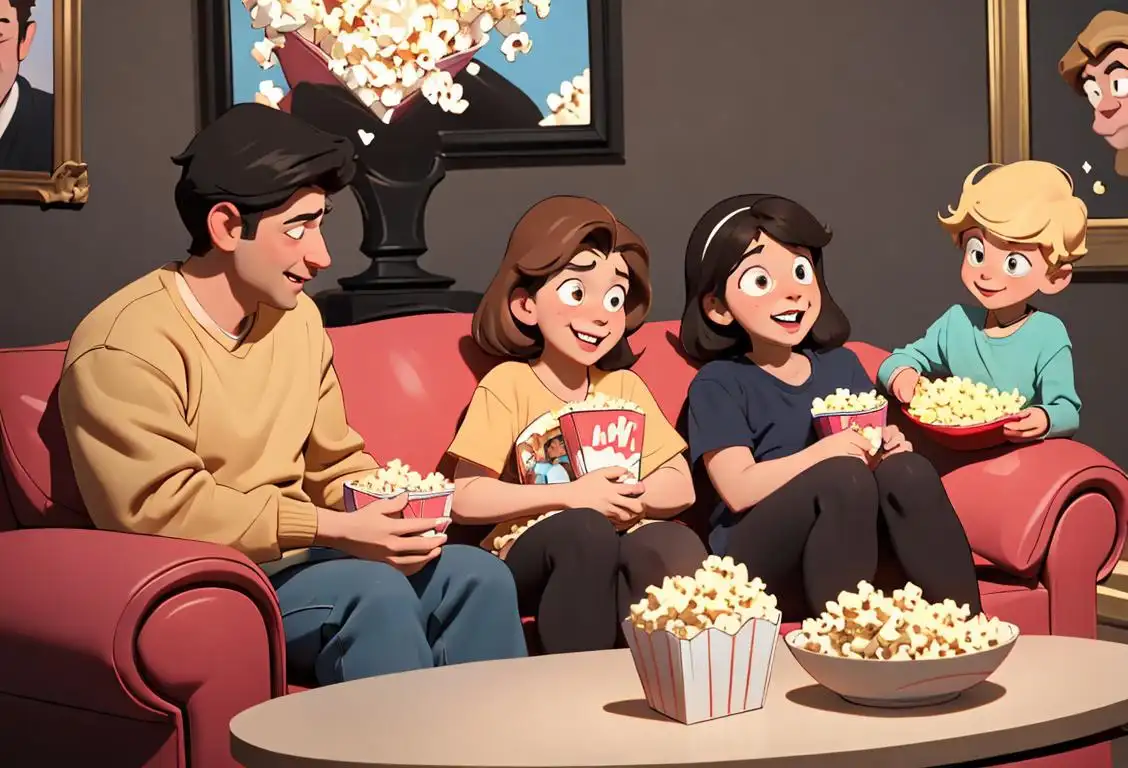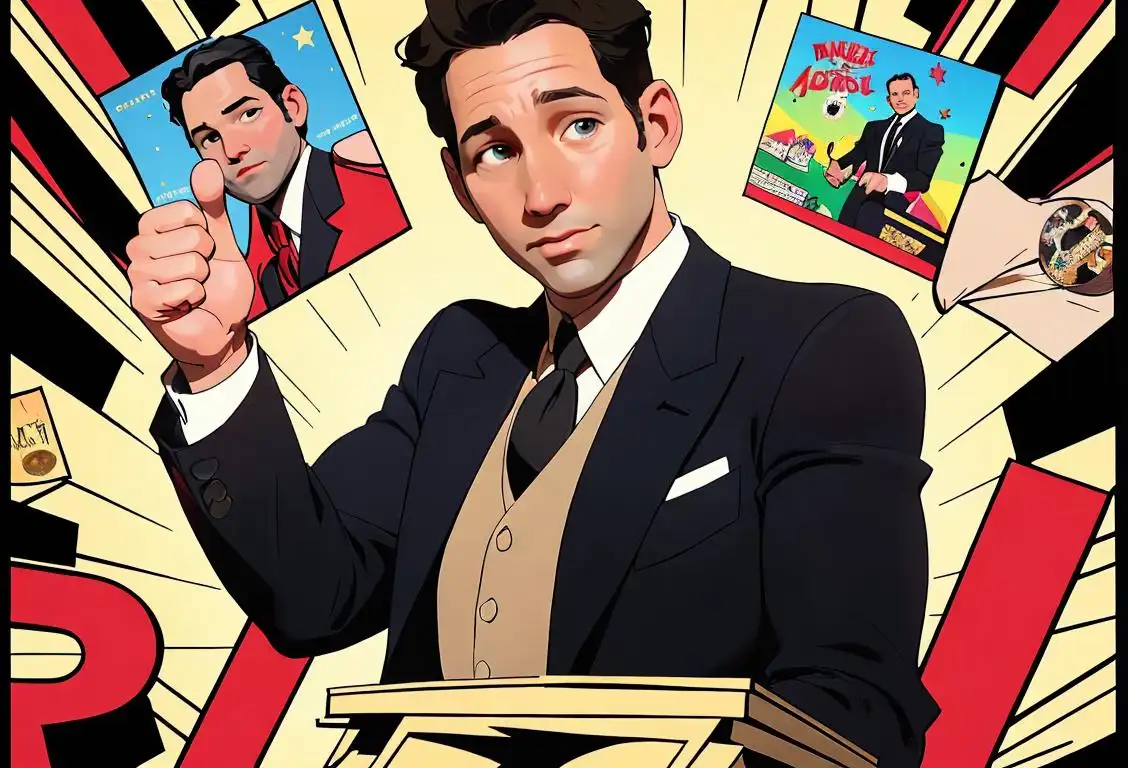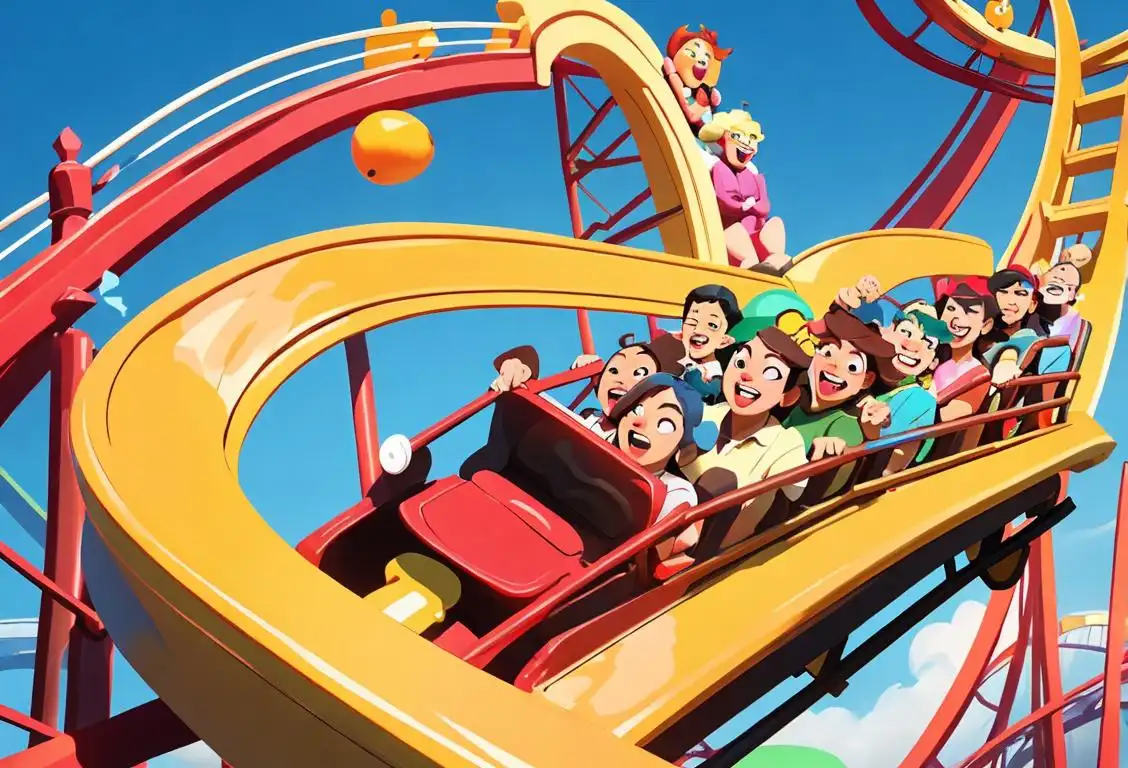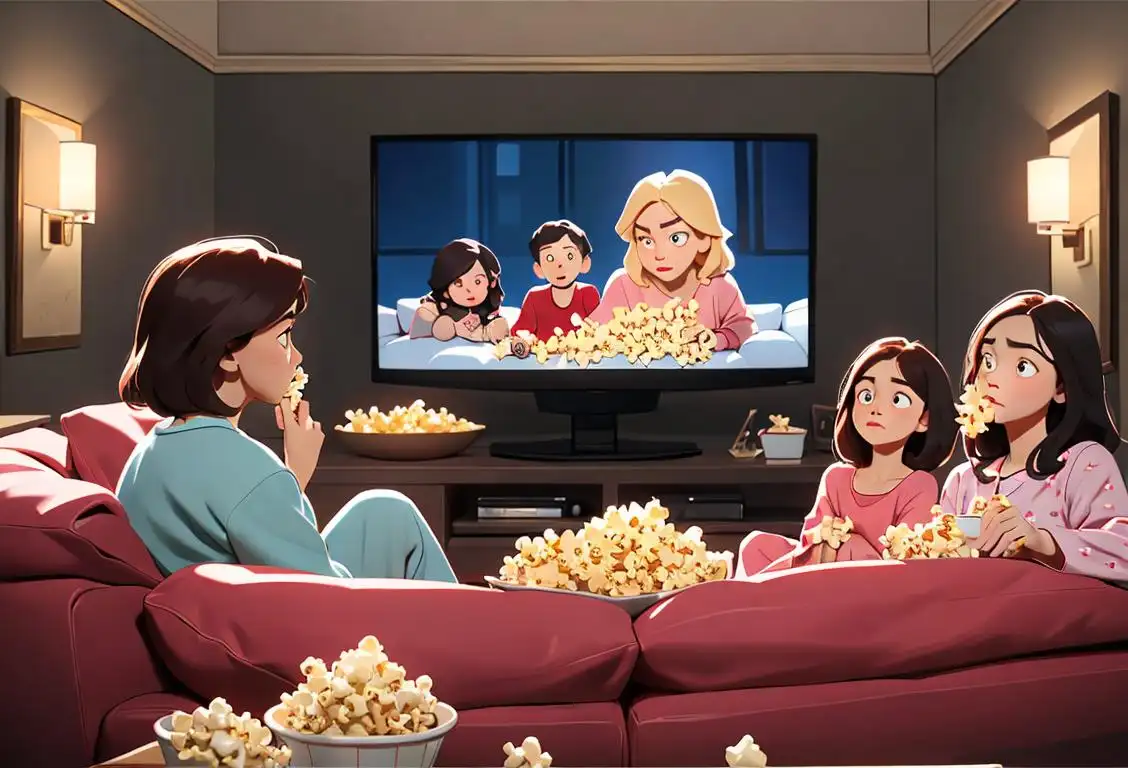National Family Tv Show Day

Welcome to the world of family TV shows! On National Family TV Show Day, we celebrate the joy of gathering together, grabbing some popcorn, and enjoying quality time in front of the small screen. Whether you're into heartwarming sitcoms, thrilling dramas, or educational documentaries, this special day is all about appreciating the shows that bring families closer. So, let's explore the history of this delightful national day and discover some interesting facts along the way!
When is Family Tv Show Day?
It's national family tv show day on the 3rd October.
The Origins of National Family TV Show Day
While the internet may not be able to trace back the exact origins of National Family TV Show Day (we suspect it was a well-kept secret among TV-loving families), we can't deny the importance of family-oriented television programming throughout history.
In the early days of television, families gathered around the flickering black-and-white screen to watch their favorite shows. From classics like 'I Love Lucy' to 'The Brady Bunch' and 'The Cosby Show,' these shows brought laughter and entertainment into households across America.
As technology advanced, so did the variety of family TV shows. Animated gems like 'The Simpsons,' 'SpongeBob SquarePants,' and 'Adventure Time' captured the hearts of both kids and adults. Drama series like 'This Is Us' and 'Parenthood' showcased the ups and downs of family life, reminding us that even on-screen families face challenges and triumphs.
Today, streaming platforms offer a seemingly endless selection of family-friendly content. From heartwarming tales to action-packed adventures, there's something for everyone in the family to enjoy.
How to Celebrate National Family TV Show Day
Celebrating National Family TV Show Day is as easy as pressing the power button on your television! Gather your loved ones, grab some snacks, and dive into an evening of binge-watching your favorite family-friendly shows.
Why not prepare a special themed dinner, inspired by the characters or setting of your chosen show? Cook up some delicious dishes that your favorite TV family might enjoy. And for extra fun, encourage everyone to dress up as their favorite characters!
Take this opportunity to discuss important themes and messages portrayed in the shows you watch together. Not only will you have a fun-filled evening, but you may also discover valuable life lessons and spark meaningful conversations.
Did You Know?
Did you know that the longest-running animated TV series is 'The Simpsons,' which first aired in 1989? It has entertained generations of viewers with its quirky humor and lovable characters. So, if you're looking for a show that the whole family can enjoy, 'The Simpsons' is a classic choice!
History behind the term 'Family Tv Show'
1950
The Emergence of Television
With the advent of television in the early 1950s, families across the United States were introduced to a new form of entertainment in their living rooms. As TV sets became more affordable, broadcasters began to experiment with programming that would appeal to a wide audience, including shows that were suitable for all members of the family.
1947
The birth of the family TV show
In 1947, television sets started becoming more common in American homes. As this new form of entertainment gained popularity, broadcasters began to realize the potential for programming that would attract a wider audience. This led to the birth of the family TV show, which aimed to provide wholesome and enjoyable content suitable for viewers of all ages. These shows typically featured relatable characters and storylines that revolved around the everyday life of a family.
1947
The Advent of Television
In 1947, television began to gain popularity and households across the United States were starting to invest in this new form of entertainment. The concept of a 'family TV show' had not yet emerged, as programming options were limited and often targeted towards adult viewers.
1926
The birth of television
Television was first invented by Scottish engineer John Logie Baird in 1926. This revolutionary device quickly gained popularity, leading to the need for programming suitable for the whole family to enjoy together.
1947
The birth of television
Television made its debut as a form of entertainment in households in 1947. It revolutionized the way people consumed media by bringing moving pictures and sound directly into their living rooms. The concept of a 'family TV show' did not yet exist, as programming was limited and catered to a general audience.
1950
The Beginnings of Television
In the 1950s, television started gaining popularity as a form of entertainment in many households. People would gather around the TV set to watch their favorite shows together. However, there was a lack of programming suitable for the whole family. Shows often contained content that was considered inappropriate for children and sometimes even for adults.
1920
The Birth of Television
The term 'family TV show' traces its origins back to the birth of television in the 1920s. As television technology emerged, it quickly became a popular medium for entertainment and information. In these early days, TV shows were primarily experimental and targeted at small audiences. Programming was limited, and there were no specific terms to describe shows that were suitable for all members of the family.
1950
The Rise of the Family TV Show
In the 1950s, television started gaining widespread popularity, and broadcasters recognized the need for shows that appealed to a broader audience. This was a time when nuclear families were becoming increasingly common, and advertisers saw the potential in creating programming suitable for the whole family. As a result, a new genre of television shows emerged, specifically designed to be enjoyed by viewers of all ages. This marked the beginning of the 'family TV show' as a recognized term in the television industry.
1950
The Rise of Sitcoms
By 1950, sitcoms (situational comedies) were starting to dominate the television landscape. Shows like 'I Love Lucy' and 'The Honeymooners' brought humor and relatable content into people's homes, making them an instant hit. While not specifically branded as 'family TV shows,' these programs were enjoyed by viewers of all ages.
1950
The rise of sitcoms
By the 1950s, sitcoms (situational comedies) became the dominant format for family TV shows. Sitcoms like 'I Love Lucy' and 'The Adventures of Ozzie and Harriet' entertained millions of viewers with their humorous storylines and relatable characters. These shows often presented idealized versions of family life, emphasizing love, togetherness, and the resolution of conflicts within the span of a single episode.
1951
Sitcoms and Variety Shows
In 1951, sitcoms and variety shows started to dominate the television landscape. These shows aimed to provide light-hearted entertainment that the whole family could enjoy together. Programs like 'I Love Lucy' and 'The Ed Sullivan Show' became hugely popular, setting the stage for the family TV show genre.
1961
The Introduction of Family-Oriented Content
In 1961, the concept of a 'family tv show' started to emerge. The show 'The Flintstones' is often considered one of the first family-oriented animated sitcoms. It featured relatable characters and storylines that appealed to both children and adults. The success of 'The Flintstones' paved the way for more shows that targeted a wider audience without compromising on content.
1948
The rise of family-oriented programming
In 1948, television networks started to recognize the importance of family-oriented programming. They began featuring shows that appealed to a wider audience, including adults and children. These shows aimed to provide wholesome entertainment and promote family values.
1952
Sitcoms for the whole family
As television expanded and audiences grew, the desire for programming specifically created for families became evident. In 1952, 'The Adventures of Ozzie and Harriet' premiered, becoming one of the first successful sitcoms focused on a family. It set the stage for future family-oriented shows by presenting relatable and humorous situations that resonated with viewers of all ages.
1960
Children's shows gain popularity
In the 1960s, a shift occurred with the introduction of children's shows designed to entertain and educate young viewers. 'The Flintstones,' which debuted in 1960, became the first animated prime-time series and showcased a family-friendly storyline centered around the Stone Age 'modern' family. The success and popularity of such shows paved the way for a broader range of family TV programming.
1952
The era of sitcoms
The 1950s saw the rise of sitcoms, which became synonymous with family TV shows. Sitcoms like 'I Love Lucy' and 'Leave It to Beaver' depicted relatable family situations with humor and warmth. These shows helped solidify the concept of a 'family TV show' as a genre.
1969
Educational Content for Families
The 1960s also saw the rise of educational programming aimed at families. Shows like 'Sesame Street,' which debuted in 1969, revolutionized children's television by combining entertainment with valuable educational content. 'Sesame Street' set the standard for future family tv shows by using creative storytelling and engaging characters to teach important lessons.
1960
The Rise of Family-Oriented Content
During the 1960s, television networks recognized the potential of catering to families specifically. They began producing shows that were centered around family dynamics and values. Successful series like 'The Andy Griffith Show' and 'The Brady Bunch' showcased relatable family experiences and tackled important issues in an accessible manner.
1969
The introduction of educational content
In 1969, the popular children's program 'Sesame Street' premiered, revolutionizing the landscape of family TV shows. 'Sesame Street' aimed to entertain and educate young viewers through a combination of engaging characters, catchy songs, and educational content. This marked a shift in the genre, as family TV shows began to incorporate a focus on teaching valuable lessons and promoting positive values.
1960
The Era of Classic Family TV Shows
The 1960s witnessed the golden era of classic family TV shows. During this time, shows like 'The Andy Griffith Show' and 'I Love Lucy' became household names and set the standard for what a family TV show should be. These shows were lighthearted, often centered around relatable family dynamics, and featured wholesome content suitable for audiences of all ages. Such shows played a vital role in shaping the cultural landscape and reinforcing societal values.
1955
The Family-Friendly Era
In 1955, television networks recognized the value of programming that appealed to the entire family. This marked the beginning of the family-friendly era, with shows such as 'The Mickey Mouse Club' and 'The Adventures of Ozzie and Harriet' becoming popular choices for households. The term 'family TV show' had not yet been widely used, but the concept was certainly taking shape.
1990
The Shift towards Diverse Family TV Shows
As society evolved, so did the concept of a family. The 1990s saw a significant shift in the portrayal of families on television. The rise of sitcoms like 'Roseanne' and 'The Fresh Prince of Bel-Air' showcased more diverse family structures and explored a broader range of social issues. This period marked the expansion of the definition of 'family' in the context of family TV shows, reflecting the changing dynamics of real-life families and embracing inclusivity.
1969
The influence of educational programming
With the launch of educational children's programs like 'Sesame Street' in 1969, family TV shows began to incorporate educational elements. These shows strived to engage both kids and adults while imparting valuable lessons, effectively blending entertainment and learning.
1987
The rise of 'The Simpsons' and animated family shows
'The Simpsons,' a groundbreaking animated sitcom, made its debut in 1987 and forever changed the landscape of family TV shows. This show brilliantly blended satire, humor, and social commentary, appealing to both children and adults. 'The Simpsons' opened the door for a new wave of animated family shows such as 'Family Guy,' 'South Park,' and 'Bob's Burgers,' which pushed the boundaries of what was considered suitable for family viewing and catered to a wider range of tastes and sensibilities.
1984
The Family Channel Launches
In 1984, the first cable network dedicated solely to family programming was launched: The Family Channel. This channel provided a platform for a wide range of family-friendly shows, including sitcoms, dramas, and animated series. It became a go-to destination for families looking for wholesome entertainment. The success of The Family Channel demonstrated the demand for content that could be enjoyed by viewers of all ages.
1970
Educational and Moral Themes
As the 1970s arrived, family TV shows increasingly incorporated educational and moral themes into their storylines. The aim was not only to entertain but also to provide positive role models and life lessons for young viewers. 'Sesame Street' debuted in 1969, pioneering this approach and setting the stage for educational children's programming.
1972
The birth of variety shows
The 1970s witnessed the rise of variety shows, which often featured a mix of music, comedy, and performances suitable for the entire family. Shows like 'The Brady Bunch Variety Hour' catered to a wide audience, bringing together the appeal of popular fictional families with the vibrant energy of musical performances. These shows aimed to provide wholesome entertainment for families to enjoy together.
1960
The Expansion of Family Programming
During the 1960s, the demand for family-oriented television content continued to grow. Networks like ABC, NBC, and CBS started actively promoting family TV shows as a distinct genre. Programmes like 'The Andy Griffith Show' and 'The Brady Bunch' exemplified this trend, providing wholesome entertainment that aimed to bring families together in front of the television set.
1987
Networks prioritize family-friendly content
In the late 1980s, networks recognized the demand for family-friendly content and began devoting specific time slots to shows suitable for all ages. This marked a conscious effort to create programming that both parents and children could enjoy together. Notable shows like 'Full House' and 'The Cosby Show' emerged during this period, emphasizing the significance of familial dynamics and moral values.
1984
The advent of family sitcoms
In the 1980s, family sitcoms became immensely popular. Shows like 'The Cosby Show' and 'Family Ties' portrayed diverse family dynamics and tackled important social and cultural issues. These sitcoms became a significant part of the TV landscape, representing the evolving definition of 'family' in society.
1990s
Expansion of Family TV Shows
During the 1990s, family tv shows continued to flourish. Networks like ABC, NBC, and CBS began to prioritize programming that catered to families. Shows such as 'Full House,' 'Home Improvement,' and 'Family Matters' became incredibly popular and became synonymous with the concept of family tv shows. These shows typically focused on relatable family dynamics and often included valuable life lessons within their storylines.
1990
The Evolution of Family TV Shows
In the 1990s, family TV shows underwent a significant transformation. Traditional sitcoms were joined by animated series that catered to both children and adults. This era introduced iconic shows like 'The Simpsons,' 'Full House,' and 'Boy Meets World.' These programs featured relatable family dynamics while exploring more diverse storytelling approaches.
Present
Modern-Day Family TV Shows
In the present day, family TV shows continue to evolve and adapt to the changing media landscape. The term 'family TV show' now encompasses a wide variety of genres and formats, spanning from animated shows like 'The Simpsons' to drama series like 'This Is Us.' These shows not only entertain but also explore complex themes, provide educational content, and foster meaningful discussions within families. The term 'family TV show' remains a testament to the enduring presence and influence of television as a medium that brings families together.
1980
Diverse Family Representations
During the 1980s, TV shows began to depict more diverse family structures, reflecting the evolving cultural landscape. Programs like 'The Cosby Show' challenged traditional notions of what a family looks like and portrayed African-American families in a positive light. This decade marked a significant shift towards inclusivity and representation in family TV shows.
2000
The advent of streaming and diverse family TV shows
With the advent of streaming platforms in the 2000s, family TV shows started to diversify even further. Streaming services like Netflix, Hulu, and Amazon Prime Video allowed for the creation of more niche and inclusive content. Shows like 'Modern Family' presented non-traditional family structures, while others like 'Black-ish' explored themes of race and identity. This era marked a shift toward more realistic and inclusive portrayals of families, reflecting the changing cultural landscape and expanding the definition of 'family TV show.'
late 1990s
Expanding horizons
By the late 1990s, family TV shows began to diversify further, reflecting changing societal norms. Shows such as 'Friends' and 'Full House' emphasized the importance of friendship and extended family relationships. This expansion of the 'family TV show' concept broadened its appeal to a wider audience.
2000
The Modern Era
With the turn of the millennium, family TV shows continued to evolve to reflect the changing times and audience preferences. The prevalence of cable and streaming services allowed for a wider variety of content, giving rise to critically acclaimed shows like 'Modern Family' and 'Stranger Things'—shows that pushed boundaries and appealed to both adults and children.
Present
Diverse Range of Family TV Shows
Today, the term 'family tv show' encompasses a diverse range of content. From animated series like 'The Simpsons' and 'Adventure Time' to live-action dramas like 'This Is Us' and reality shows like 'American Ninja Warrior,' there are numerous options available for families to enjoy together. Family tv shows continue to evolve to reflect the changing dynamics and interests of modern households, promoting unity and shared experiences.
2000s
Diversity and inclusivity in family TV
The 2000s witnessed a notable shift in the representation of families on television. Shows like 'Modern Family' celebrated non-traditional family structures, highlighting diversity and inclusion. This era also saw the rise of animated programs that appealed to all ages, such as 'The Simpsons,' 'Family Guy,' and 'Bob's Burgers.' These shows pushed boundaries while maintaining their status as family TV, challenging the notion of what constitutes a 'family.'
1990
The Power of Animations
In the 1990s, animated TV shows gained immense popularity within the family genre. Series such as 'The Simpsons,' 'Rugrats,' and 'Animaniacs' captured the attention of both children and adults. With their clever humor and storytelling, animated family TV shows proved to be a hit across different age groups.
2000
Streaming and On-Demand Era
The 21st century ushered in a new era of family TV shows with the rise of streaming services and on-demand content. Families now had access to a wide range of shows and could watch them on their own schedules. This shift in viewing habits gave rise to shows like 'The Office,' 'Friends,' and 'Modern Family,' which gained popularity by providing relatable, comedic family dynamics.
Present
The digital era
In the present day, the term 'family TV show' continues to evolve with the advent of streaming platforms and on-demand content. Families now have access to a vast array of shows catering to their diverse interests and preferences. The concept of a 'family TV show' remains integral to fostering shared viewing experiences and maintaining familial bonds.
Present
Diverse Selection and Streaming Platforms
Today, the term 'family TV show' encapsulates a wide range of programming, from animated series to dramas and reality TV. Streaming platforms like Netflix, Hulu, and Disney+ have further expanded the options available to families worldwide, ensuring that there is something for everyone to enjoy together. The concept of a 'family TV show' remains as popular as ever, providing shared viewing experiences and promoting family bonding in the digital age.
Did you know?
Did you know that the longest-running animated TV series is 'The Simpsons,' which first aired in 1989?Tagged
fun loved ones entertainmentFirst identified
3rd October 2016Most mentioned on
3rd October 2016Total mentions
12Other days
Paul Rudd Day
Head Ass Day
Theatre On Christmas Day
Tv Every Single Day
Television And Spontaneously Combust Day
Coaster Day
Best Dick Day
Agenda By Watching Tv All Day
Television Day
Awards Day







